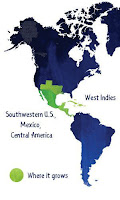Aloe Vera Farmers Collaborate to Reduce Waste
 |
| In addition to Southeast Asia, Aloe Vera production is exclusive to Central America and the Southwestern U.S. |
Despite the unique economic value of aloe vera plants, smallholder farmers in Guatemala still face a major barrier to profitability. At La Floresta Aloe Farm in the Western Highlands of the country, the resources required to cultivate a crop of plantlets for export are often double what they should be. More than 50% of plants they grow are rejected due to mechanical damage during harvest, stunted growth, and
improper herbicide spraying techniques. Poor plant nutrition has also resulted in extremely low growth rates. During 2014, there were only about eight plantlets
per exportable aloe Vera plant, far below the expected 35 plantlets (that's 77% underproduction!) To address this issue,
Farmer-to-Farmer connected La Floresta with integrated pest management and plant nutrition specialists Dan Culbert and Shawn Steed. Both volunteers brought prior experience working with aloe vera, as well as improving management practices for other crops and ornamental plants.
The team took time to meet with the host organization and F2F field staff via Skype prior to their departure for Guatemala. After outlining a game plan, they wasted no time getting down to business when they arrived on site. By improving plant nutrition and harvesting techniques, farmers aimed to
reduce plant rejection rates to no more than 5% and salvage an additional 45% of their crop. Dan and Shawn drew on their wealth of combined experience to recommend fertilizer rotations, specialized selection of mother plants, and improved integrated pest management (IPM) practices.* Between analyzing compost for composition of nutrients and experimenting with vinegar as an herbicide, farmers at La Floresta were left with a comprehensive toolkit of ways to improve production and export more plantlets.
 |
During the two week assignment
Jorge Dieguez
accompanied and explained all the nutritional and
pest problems
that La Floresta was dealing with.
|
Highly specialized projects like this one help us work towards Farmer-to-Farmer’s goal of improving livelihoods and promoting sustainable development throughout Latin America and the Caribbean. Because of Dan and Shawn’s assistance, smallholder farmers will increase their incomes, waste fewer agricultural resources, and sooth more sunburns using aloe vera grown in Guatemala!
 |
| Volunteers Dan Culbert (left) and Shawn Steed (center) assisting a local ornamental producer in Cobán Alta Verapaz. |
*Integrated pest management is a broad-based approach that integrates practices for economic control of pests.

.png)

Comments
Post a Comment